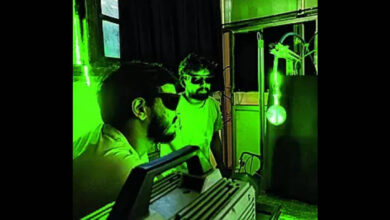Robot-Explorers, Futuristic SpaceX Starships Set To Transform The Moon

SpaceX Starship rocket prototypes inside the Starbase Launch Center – the precursors to ships … [+]
Squads of American explorers are counting down to rocketing to the Moon, armed with leading-edge technologies that set the stage for a new branch of civilization to bring life to its ancient craters.
This new generation of discoverers, which begins launching later this year, includes 3D mapmakers and photographers, prospectors for the Moon’s most precious treasure – H2O – and even creators of a prototype to link the silver orb in an Inter World Web with the Earth.
Although created in the image of their human makers, these scouts will all be robotic, designed to build a foundation for oxygen-breathing astronauts to follow about two years later.
A quickening robotics revolution back on Earth is powering this new phase of lunar reconnaissance, along with plans to robotically construct landing pads, science labs and habitats around the South Pole of the Moon, says Professor Kip Hodges, who as founding director of the School of Earth and Space Exploration at Arizona State University transformed the school into one of the leading American space studies centers.
Rapid advances in creating “swarms” of interlinked AI-enhanced robots, and in global “cloud robotics” networks that allow them to learn from each other, are remaking the realm of space robotics and its future, Hodges tells me in a series of interviews.
This multi-faceted revolution is paving the way for robots to build out the first human base camps in advance of the new-generation astronauts touching down.
Intuitive Machines IM-1 Lunar Lander, set to be launched on a SpaceX rocket. A new generation of … [+]
A simultaneous revolution in spaceflight is super-charging this new-millennium race to the Moon. Despite the fantastic pyrotechnical explosions that have lit up SpaceX’s first three test flights of its experimental Titan-size booster and capsule, the twin-stage “Starship is a technological marvel,” Professor Hodges says.
“The size of the ship is one key to its future value for planetary exploration and settlement. Whether we’re considering building permanent research or mining stations on the Moon or cities on Mars, there is need for transporting large masses of equipment and materials from Earth.”
“Starship is designed to do that better than any competing vehicle at this point.”
Starship’s explosive transition – from SpaceX design labs to its widely predicted seizing the global leadership in spaceflight – in myriad ways resembles the halcyon days of NASA’s own birth in the race with the Russians to the Moon, when an array of NASA’s first ICBMs-turned-rockets ended their short lives in flames.
When SpaceX’s super-ship completes its NASA-commissioned mission to shuttle Artemis astronauts between lunar orbit and the impact craters surrounding the pole, he says, “There is no doubt that Starship will go down in history as a major revolution in human spaceflight.”
In a preview of the Artemis III mission that will speed a pair of American astronauts to the Moon for the first time since the last century, NASA’s leaders say the Starship “will serve as a habitat on the lunar surface for the early Artemis missions” and as a Moon-orbiting space station that doubles as a research outpost.
When SpaceX’s top spaceflight engineers, vanguard NASA scientists and leading space experts across American universities, including Professor Hodges, joined together to prefigure the next stages of off-world exploration, the group predicted the first human settlements on the Moon, and later on Mars, will be built around clusters of Starships.
That was then: Apollo 16 astronaut with Lunar Roving Vehicle on the Moon. Next-generation astronauts … [+]
“A unique aspect of Starship is its capacity for large-scale transport of people to a planetary surface,” they say in a jointly scripted paper. “This could drive accelerated development of a sustained presence on the lunar surface.”
“Crewed Starships will have on the order of 1100 m3 forward space (most of which will be pressurized for human habitation).”
That’s more habitable space than on the massive International Space Station, and each future Starship could ferry “up to 100 people from Earth into LEO and on to the Moon,” SpaceX says in a Starship Users Guide. The ships will be decked out with “private cabins, large common areas, centralized storage, solar storm shelters and a viewing gallery.”
During a fantastical overview on Starship’s future presented at SpaceX’s Starbase launch center in April, Elon Musk said specially designed Moon Starships would be deployed like lighthouses illuminating SpaceX’s celestial outpost on the Moon.
“Ultimately I think we we want to build a Moon base – Moonbase Alpha – and have a permanently occupied base on the Moon,” he predicted.
Another squadron of Starships will form a Trans-Lunar Express, perennially ferrying voyagers between orbital way stations circling the Earth and the Moon. These ships will be refuelled in low Earth orbit, he said, and would “never land back on Earth.”
Meanwhile, the spaceflight engineers from SpaceX’s inner circle revealed in their joint white paper that early Moon-bound Starships “will likely each have about 10-20 total people onboard.”
With an immense cargo hold that can transport 100+ metric tons, each Starship could also speed bands of robots to their new expeditions across the Moon, they said.
Hodges and other NewSpace scholars at ASU are set to be central players in the new rush to uncover the Moon’s age-old secrets and help shape its future exploration: “We are already hard at work building digital twins using Lunar Reconnaissance Orbiter data for some of the candidate Artemis III landing sites,” he says.
His Digital Discovery Initiative lab will transform these digital dioramas into futuristic virtual reality simulations – Moon doppelgänger worlds that researchers and spacefarers donning VR headsets can trek through while zooming in on the super-real imagery.
A one-time member of NASA’s Space Advisory Council who has helped instruct American, Canadian, and Japanese astronauts, Hodges says a kaleidoscope of these virtual lunar landing sites that his skunkworks group is now building could enable NASA’s Artemis spacefarers, outfitted with VR headgear, to conduct forays across these scenes before actually descending on the Moon.
While now constructing virtual looking glass worlds of Moon sites surveyed by orbiting satellites, he says the ultimate goal is to rapidly build simulations from imagery captured by robotic photographers before and during the early stages of Artemis landing missions.
At breakneck speed, his team would produce virtual reality renditions to guide Artemis Moonwalkers in planning new expeditions. Using these hyper-tech VR simulacrums, “The astronauts could plan their [next] extraterrestrial sorties before leaving the relative safety of the ship,” he explains, and thereby limit their exposure to the higher radiation levels of the lunar surface. “This would retire a lot of the risk involved in surface exploration.”
A leading advocate of tele-operating planetary robotic scouts from orbiting spacecraft, Professor Hodges says astronauts positioned on the Gateway lunar space station “could precisely maneuver robots on the Moon’s surface to survey deeply shadowed craters and lava tubes where human operations can be exceedingly dangerous.”
Astronauts on the International Space Station have already tele-operated robots on Earth, and their … [+]
Experimental robots are slated to lead a secession of tech demo missions in the run-up to the first astronaut touchdown. An Intuitive Machines lander set to reach the Moon later this year will drill into the frozen lunar regolith to search for water ice, and will carry an experiment crafted by Nokia and Bell Labs to create a “space-hardened 4G/LTE network,” NASA revealed in a press release.
The goal is to assemble the Moon’s first wireless network, which ultimately expands to enable “even high-definition video streaming from astronauts” between the two worlds.
Nearby, NASA’s Jet Propulsion Lab is set to release a “swarm” of super-intelligent robot-explorers equipped with stereo cameras and charged with creating photorealistic 3D maps of the lunar terrain.
These CADRE bots represent the next leap in creating autonomous robots that can communicate with each other via a mesh radio network and collectively decide how to carry out their mission.
NASA Jet Propulsion Lab engineers, who designed the Mars Ingenuity Helicopter, have developed a … [+]
Mission controllers back on Earth will provide only broad guidelines to their lunar envoys – like “explore and map this quadrant of the crater” – and the droids will dialogue to reach a consensus on how to best reach that objective. In a remarkable experiment in radical robotic democracy, once each hour the team will elect a leader to spearhead the next stage of their expedition, conducting the Moon’s first trial of a utopian political system.
“It could be a game-changing way of doing science,” says Subha Comandur, CADRE project manager at JPL, which is part of Caltech.
Radical success with this troupe of robot-democrats and their mapmaking odyssey, he adds in a press release, “could change how we do exploration in the future.”



